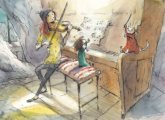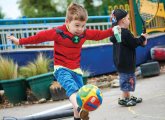Maria Kay highlights the close relationship between music and literacy in the early years, and suggests simple activities to help you develop children’s skills…
There are many ways in which sounds, and music in particular, can support children’s developing communication skills.
A baby’s first efforts to communicate involve listening and responding to various sounds. Later, toddlers begin to imitate words, then to interpret symbols around them. Eventually they make their own symbols to record and communicate.
Children can hear prior to birth. They are therefore learning from the sounds they encounter even before they enter the world. This was outlined by Peter Hepper back in 1994 in an episode of Channel 4’s Equinox entitled ‘Brave New Babies’.
Hepper found that a child’s development could be stimulated through music in the womb, and music’s importance continues from this point throughout a child’s early years.
Its use offers us a way to help children to imitate the sounds they hear. We can use it to train their listening skills, too.
Research has demonstrated that singing in a foreign language can provide a significant helping hand for those learning how to speak it.
The same principle applies for our first language. As adults, many of us will remember lyrics and melodies we learned long ago.
Music can encourage sound-making both with the voice and instruments. Musical activities can aid memory and provide a wonderful medium for learning.
Children can learn to sing before they can speak, so music can provide them with an early means of communication.
Encouraging children to listen carefully and pay attention to variations in sound, and to respond to what they hear, is very important to later literacy.
They will need to be able to differentiate the sounds within words in order to read and write them.
Music is the perfect medium for helping children to listen and respond. Listening to music and singing help to improve vocabulary, diction, comprehension and an appreciation of language structure.
Very young children love ‘finger plays’. These are action rhymes or songs where children can use their hands to join in. An example would be the well-known ‘Incy Wincy Spider’ or ‘Open Shut Them’:
Open, shut them, open, shut them,
Give a little clap.
Open, shut them, open, shut them,
Lay them on your lap.
Creep them, creep them, creep them, creep them, Right up to your chin.
Open wide your little mouth,
But do not let them in!
Perform actions according to the lyrics above, starting with the opening and closing of fists. At the end, when your fingers reach your open mouth, quickly hide them behind your back.
Calm sea, calm sea;
rough sea, rough sea;
stormy sea, stormy sea, SPLASH!
After you say each phrase once, children can repeat it or say it with you the second time. Get louder each time.
Using a parachute or waving your arms, make increasingly bigger movements to go with the words. At the end encourage children to shout “Splash!” with you. Pat both hands on the floor as if to splash in the water.
Singing helps children to develop fluency of oral communication skills. It offers an opportunity to be vocal in a controlled way. It helps children to listen attentively and to produce a variety of sounds.
A traditional song that’s a favourite of children I work with, and of mine, is ‘Alley Alley O’. Perform this with children sitting on an adult’s knee so they can ‘bounce’ with the waves, or use a parachute.
The actions for the first verse involve making wave motions with your hands or waving the parachute. For the second verse shake your head and waggle a finger.
For the third verse, tip children towards the floor (great excitement!), or with a parachute, lean forwards and put hands into the sea.
These music and literacy activities are ideal for early years children. Being immersed in language helps them to learn. Using music adds another dimension to embed and consolidate this learning.
Maria Kay is the author of Sound Before Symbol: Developing Literacy through Music and Alphabet Book + More: A Sounds and Symbols ‘Literacy Through Music’ book. Her Sounds and Symbols Literacy through Music Resource Pack is a comprehensive, research-based and informative resource, full of engaging activities. Visit bryantandkaypublishing.co.uk

Inspiring picture books for budding musicians
Editors picks

ICT in Early Years – How to make online learning fun
Editors picks

EYFS outdoor maths – Fun games to try in your setting
Editors picks
